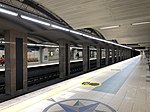Rossio
Neoclassical architecture in PortugalPalladian Revival architectureSquares in Lisbon

The Rossio is the popular name of the King Pedro IV Square (Portuguese: Praça de D. Pedro IV) in the city of Lisbon, in Portugal. It is located in the Pombaline Downtown of Lisbon and has been one of its main squares since the Middle Ages. It has been the setting of popular revolts and celebrations, bullfights and executions, and is now a preferred meeting place of Lisbon natives and tourists alike. The current name of the Rossio pays homage to Pedro IV, King of Portugal. The Column of Pedro IV is in the middle of the square.
Excerpt from the Wikipedia article Rossio (License: CC BY-SA 3.0, Authors, Images).Rossio
Dom Pedro IV Square, Lisbon Santa Maria Maior (Santa Maria Maior)
Geographical coordinates (GPS) Address Nearby Places Show on map
Geographical coordinates (GPS)
| Latitude | Longitude |
|---|---|
| N 38.713888888889 ° | E -9.1394444444444 ° |
Address
Dom Pedro IV
Dom Pedro IV Square
1100-199 Lisbon, Santa Maria Maior (Santa Maria Maior)
Portugal
Open on Google Maps








